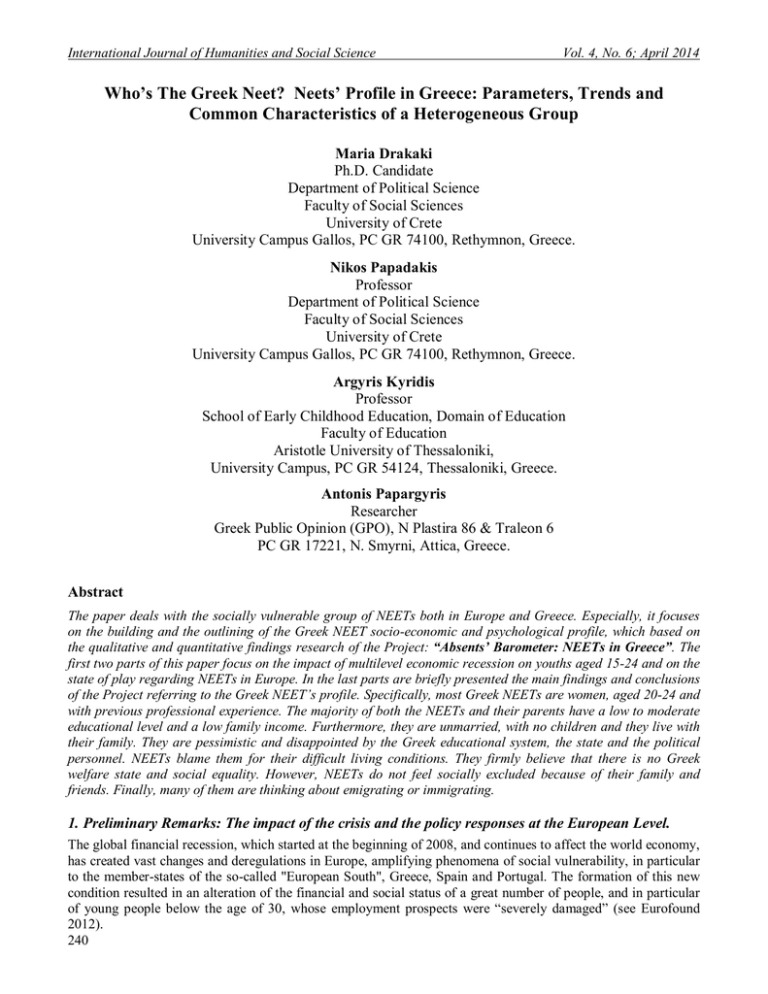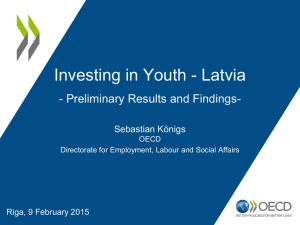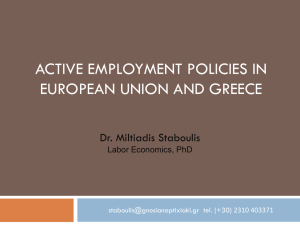Document 10465656
advertisement

International Journal of Humanities and Social Science Vol. 4, No. 6; April 2014 Who’s The Greek Neet? Neets’ Profile in Greece: Parameters, Trends and Common Characteristics of a Heterogeneous Group Maria Drakaki Ph.D. Candidate Department of Political Science Faculty of Social Sciences University of Crete University Campus Gallos, PC GR 74100, Rethymnon, Greece. Nikos Papadakis Professor Department of Political Science Faculty of Social Sciences University of Crete University Campus Gallos, PC GR 74100, Rethymnon, Greece. Argyris Kyridis Professor School of Early Childhood Education, Domain of Education Faculty of Education Aristotle University of Thessaloniki, University Campus, PC GR 54124, Thessaloniki, Greece. Antonis Papargyris Researcher Greek Public Opinion (GPO), N Plastira 86 & Traleon 6 PC GR 17221, N. Smyrni, Attica, Greece. Abstract The paper deals with the socially vulnerable group of NEETs both in Europe and Greece. Especially, it focuses on the building and the outlining of the Greek NEET socio-economic and psychological profile, which based on the qualitative and quantitative findings research of the Project: “Absents’ Barometer: NEETs in Greece”. The first two parts of this paper focus on the impact of multilevel economic recession on youths aged 15-24 and on the state of play regarding NEETs in Europe. In the last parts are briefly presented the main findings and conclusions of the Project referring to the Greek NEET’s profile. Specifically, most Greek NEETs are women, aged 20-24 and with previous professional experience. The majority of both the NEETs and their parents have a low to moderate educational level and a low family income. Furthermore, they are unmarried, with no children and they live with their family. They are pessimistic and disappointed by the Greek educational system, the state and the political personnel. NEETs blame them for their difficult living conditions. They firmly believe that there is no Greek welfare state and social equality. However, NEETs do not feel socially excluded because of their family and friends. Finally, many of them are thinking about emigrating or immigrating. 1. Preliminary Remarks: The impact of the crisis and the policy responses at the European Level. The global financial recession, which started at the beginning of 2008, and continues to affect the world economy, has created vast changes and deregulations in Europe, amplifying phenomena of social vulnerability, in particular to the member-states of the so-called "European South", Greece, Spain and Portugal. The formation of this new condition resulted in an alteration of the financial and social status of a great number of people, and in particular of young people below the age of 30, whose employment prospects were “severely damaged” (see Eurofound 2012). 240 © Center for Promoting Ideas, USA www.ijhssnet.com The living conditions and living standards of the unemployed are further deteriorated in the event they lack alternative sources of income or if they don’t qualify for support from the welfare state, e.g unemployment benefits. The lack of either psychological support, e.g from the family, or social networking, e.g. from friends, is likely to intensify the existing bad living conditions of the unemployed. As mentioned in the study ‘NEETs in Europe: Convergences and divergences’, (Papadakis, 2013), the age group most affected by unemployment is young people between the ages 15 to 24 (see European Commission, 2011a: 5). The European Commission has already characterized this age group as a ‘lost generation’, and not without reason, as the possibility of a young person entering into long-term unemployment with no future prospect for a permanent occupation is steadily increasing (European Commission, 2011a: 5). The unemployment rate of people aged 15-24 is much higher than the unemployment rates of all other age groups. While up to 2008, the youth unemployment rate was almost twice as high as the total unemployment rate of the EU, reaching its minimum value (18%) at the beginning of 2008 (Eurostat, 2013a http://epp.eurostat.ec.europa.eu/statistics_explained/index.php/Unemployment_statistics), from the beginning of 2009, this ‘gap’ started to widen and reached 2.6 times the total unemployment rate of the EU-27 at the end of 2012 (Eurostat, 2013a http://epp.eurostat.ec.europa.eu/statistics_explained/index.php/Unemployment_statistics). If we look into the near past, we will certainly recall an announcement of the European Commission back in 2008 for ‘A Renewed Social Agenda for Opportunities, Access and Solidarity in the 21st century’. One of the seven priorities of the Commission was the following: «Europe's future depends on its youth. Yet, life chances of many young people are blighted -they lack the opportunities and the access to education and training to realize their full potential…. The problems of high youth unemployment, too many early school-leavers, and the relative job insecurity and wage inequality faced by younger people have to be tackled» (Commission of the European Communities, 2008:8) Two years later, on March 2010, during the Announcement of the Commission for the new European Strategy «Europe 2020», the President of the European Commission José Manuel Barroso has pointed out that the two year period 2008 to 2010 has left millions unemployed. The main purpose of the «Europe 2020» strategy is to form a future with more jobs and better lives (European Commission, 2010). The new Strategy «EU2020» puts forward three mutually reinforcing priorities: 1. « Smart Growth: developing an economy based on knowledge and innovation. 2. Sustainable Growth: promoting a more resource efficient, greener and more competitive economy 3. Inclusive Growth: fostering a high-employment economy delivering social and territorial cohesion» (European Commission, 2010: 5). Five key targets have been set towards the accomplishment of these priorities. Three of them are directly or indirectly related to education, to the creation of links between the education and training systems and employability, to the labour market and the combat of unemployment, poverty and social exclusion: a) 75% of the population aged 20-64 should be employed b) b) the drop-out rate of the early school leavers shall be reduced to below 10%; the share of the population aged 30-34 having completed tertiary education shall be increased to at least 40% c) the number of people living below poverty lines shall be reduced by 20 million (European Commission, 2010: 5) A series of relevant large scale initiatives have been adopted to this purpose (European Commission, 2010: 15-16 & 21-24), as discussed in Papadakis 2013. It is worth to recall the rates for youth unemployment of that year. More specifically, on December 2010, the unemployment rate of young people below the age of 25 was 21% in the EU-27, with small variations between sex (men: 21,2%, women: 20,7%). This rate remained consistent in 2011. In Greece, the rate for the same period was 37,1% (women: 43,9%, men: 31,5%) (see Eurostat, 2013b. 241 International Journal of Humanities and Social Science Vol. 4, No. 6; April 2014 http://epp.eurostat.ec.europa.eu/tgm/refreshTableAction.do?tab=table&plugin=0&pcode=teilm021&language=en) . At the end of 2012 youth unemployment rate in EU was increased up to 23,2% and in Greece up to 57,9%. (Eurostat 2013a), while at September 2013 the relevant rates were 23,5% and 59,2%. 2013: Three years after the announcement of the priorities set by the EU2020 Strategy, and despite the commitments of President Barroso, these targets have not yet been attained. Youth unemployment has dramatically risen, there is a lack of job offerings in relation to the existing labour force and a large number of Europeans are living below poverty lines. The phenomenon of youth unemployment has been a major concern for policy makers since the 1980s, despite the fact that unemployment rates on young persons have always been higher than those of other age groups (Eurofound, 2012: 4). Youth unemployment rates tend to increase more than those of other groups during periods of economic recession (Freeman and Wise, 1982, as cited in Eurofound, 2012: 4). Young people seem to be more affected by the economic crisis and can be considered the most vulnerable population group among the economically active population, as a series of characteristics and events tend to increase the unemployment rates among young people. 2. On the state of play regarding Neets in Europe. Labour force participation rate usually takes into account employment and unemployment rates. In other words, it measures people that are already employed and those that seek employment (Eurofound, 2012: 19). «While the integration of young people into society has been traditionally imagined as a sequence of steps from school to work, it is now recognised that such linear transitions are increasingly being replaced by diversified and individualised trajectories from school to work. Modern youth transitions tend to be complex and protracted, with young people moving frequently in and out of the labour force. They may involve backtracking and blending of statuses – especially in times of economic turbulence. Additionally, greater emphasis is given today to individual responsibility as a driver of young people’s trajectories, while institutional and structural factors (such as parents’ social class, ethnicity and economic status) are becoming more diversified. Consequently, traditional approaches to understanding the vulnerable position of young people in the labour market have become less effective, as many of these transitions are not captured by conventional indicators of unemployment» (Eurofound, 2012: 19). All these parameters should be taken into account when trying to interpret the recently studied (but not new) socially vulnerable group: namely the NEETs, young people aged 15-24 not in Education, Employment or Training (see European Commission, 2008: 130, International Labour Office, 2012: 9). How was the term NEET introduced? What are the characteristics of this group? Which are their similarities and differences with young people aged 15-24? Why is it imperative to systematically map and study this new socially vulnerable group? «The term NEET was formally introduced at the political level in the UK in the late 1990s (more specifically, in 1999), in response to the need for the development/formation of an indicator to capture people aged 16-18 who were not in education, employment or training» (Social Exclusion Unit, 1999 as cited in Eurofound: 20). The changes made in the UK benefit regime for the unemployed at that time, left most of those aged 16–18 years without access to unemployment benefits (Furlong, 2006, as cited in Inui, 2009: 176, Furlong, 2007, as cited in Eurofound, 2012: 19). More specifically, the term NEET was introduced in the government report “Bridging the Gap”. This report aimed to study this category of young people, estimate the scale of the problem, the factors that contribute to the vulnerability of the group but also, to study the heterogeneity among its population so as to propose policy actions to address the phenomenon (Social Exclusion Unit, 1999: 6-9). At the beginning, this term was associated with early school leaving in order to address the strikingly increasing percentages of early school leavers, and the priority given by the Lisbon Strategy on this issue (see Diagram 1). 242 © Center for Promoting Ideas, USA www.ijhssnet.com The term NEETS has been formally introduced in EU documents in 2008 (see European Commission, 2008: 130131 and Papadakis, 2013), while recent statistical data for the UK in 2007 based on Statistical First Release (SFR) demonstrated that 10% of young people aged 16-18 were NEETs (Statistical First Release, 2007 as cited in European Commission, 2008: 130). The concept of the NEETs is now an international phenomenon, despite the differences in the definitions used to describe it (Eurofound, 2012: 19-21, European Commission, 2008: 130-131, European Commission, 2011c: 1-2)1. Apart from Europe “NEETS group has become a massive problem, for families, governments and society in many countries in Asia”, (Liang 2009: 18), including mainly Japan, China and Korea. The status of NEET “affects the life chances of many of these young people as they face the possibility of long-term unemployment, isolation and social exclusion” (Simmons, R. & Thompson, R., 2011: abstract). According to OECD, within the period 2000-2010, Neets’s rate in the OECD countries decreased down to 0,7%. But since 2008, when the global financial crisis started, till 2010, the Neets’ rate increased from 13,7% (2008) to 15,8% (2010). Spain (23,7%), Italy (23%) and Ireland (21%) face a major problem regarding Neets (OECD, 2012 cited in International Labour Office, 2013: 90) (see Table 1). In Ireland Neets’ rate increased up to 7,8% (2008: 12,8%, 2010: 21%), while in Spain the rate increased up to 6,9% (2008: 16,8%, 2010: 23,7%) (OECD, 2012 cited in International Labour Office, 2013: 90). In Greece, another country heavily affected by the crisis, the Neets’ rate increased from 16,2% (2008) to 18,3% (2010) (OECD, 2012 cited in International Labour Office, 2013: 90) (see Table 1). In 2012, there were 7.469.100 Neets in EU, namely 12,9% of the youth population (Eurofound 2012: 23). Countries facing severe problems regarding Neets include Italy (19,8%), Greece (17,4%), Spain (18,5%), Bulgaria (22,6%) and Ireland (18,4%). (Eurofound, 2012: 28-29) (see Table 2). It’s more than obvious that there is a direct colleration between the impact of the crisis and the Neet rate. The majority of Neets, aged 15-24, are low skilled (especially in Netherlands, Denmark, Germany, Bulgaria, Austria and Romania- see Eurofound 2012: 31). On the other hand there are remarkable exceptions, namely countries where Neets have a higher educational level. Greece is one of them, since more than 25% of the Neets are Higher Education Graduates. Different terms to describe the NEETs have also been adopted, at a European and international level: “Angry young rebels, Quitters, Rebels without a cause, Cool dudes, Hedgers, Settlers, Escapists, Strugglers” (BBC news, 5 November 2007 as cited in European Commission, 2008: 132). The terms above are used to describe –in our opinion in a non-realistic, ambiguous, untargeted and most importantly, non-scientifically established manner – this socially vulnerable group. Moreover, the descriptions used are usually confused with the profiles of early school leavers and they end up been included in the socially vulnerable NEET group (European Commission, 2008: 131-132). Yet, NEETs are not only the early school leavers. Unlike the above descriptions, which present the NEETs as a generation of passive and «lazy» young people, low skilled and having behavioral problems, no dreams and ambitions, this «absence» of the young from the main institutions, that is, the education, training and employment systems, is usually not a personal choice but rather «….(can be interpreted) as a weakness and a failure of the dominant value system to restrain, inspire and give a meaning to their life course, showing them prematurely and hastily the exit to the tough arena of reality…. » (Fotopoulos, 2010: §4) In fact, all descriptive terms that attempt to transfer the responsibility from the general context to the person should be treated with scrutiny. Today, despite the lack of an internationally defined term for the NEETs2, an indicator has been developed in the EU (NEET indicator), which has been widely used since the beginning of the recession to perform cross-country comparisons at a European (EU) and also at an international level (OECD countries). 1 However, OECD expands the age range of NEETs to 15-29 (OECD, 2012: 22). The term NEET in most European countries refers to young people aged 15-24 (European Commission, 2013c: 2), in Japan, to young people aged 15-34 (OECD, 2008 as cited in Eurofound, 2012: 20), in OECD’s data, to young people aged 15-29 2 243 International Journal of Humanities and Social Science Vol. 4, No. 6; April 2014 More specifically, in the EU, the concept and the indicator on the NEETs is used to monitor the labour market as well as the social situation of young people (Eurofound, 2012: 21-22, European Commission, 2011c: 1-2). The need to monitor the NEETs is essential, considering the sharp increase of their percentages. It is worth mentioning that the NEET rate has increased more than 5 percentage points in the period 2008-2010 in countries such as Ireland, Estonia, Iceland and Spain. (OECD, 2012 as cited in the International Labour Office, 2013: 90). According to the OECD, several countries express serious concerns in respect to the rise of the percentage rate of the NEETs, since it is quite common for people who have quit the education system early and have not joined the labour force to engage in ‘informal’ – illegal economy activities and criminality (OECD, 2008 as cited in OECD, 2013: 330). Moreover, the association between unemployment and mental health, anxiety levels, depression and suicides has long been well established (OECD, 2008: 4-5). Eurofound’s recent report (2012), is a first class «raw material» for mapping the socially vulnerable group of NEETs at a European level and performing cross-country analysis of the characteristics of the NEETs. NEETs in Europe may be classified in five main sub-groups: “the conventionally unemployed, the largest subgroup, which can be further subdivided into longterm and short-term unemployed; the unavailable, which includes young carers, young people with family responsibilities and young people who are sick or disabled; the disengaged: those young people who are not seeking jobs or education and are not constrained from doing so by other obligations or incapacities, and takes in discouraged workers as well as other young people who are pursuing dangerous and asocial lifestyles; the opportunity-seekers: young people who are actively seeking work or training, but are holding out for opportunities that they see as befitting their skills and status; the voluntary NEETs: those young people who are travelling and those constructively engaged in other activities such as art, music and self-directed learning” (Eurofound, 2012: 24). It is worth to note that there is a higher probability of ending up NEET for young people with low levels of education, an immigration background, some level of disability or problems of mental health as well as young people with a problematic family background (Eurofound, 2012: 55-56). In several cases “for some young people it is their health, low school attainment, bullying or parenthood that are associated with becoming NEET, for others it is a much more complex picture of multiple and mutually reinforcing issues” (Hutchinson, Korzeniewski and Moore, 2011: v). This heterogeneity in the NEETs –and potential NEETs - population needs to be taken very seriously in policymaking, designed to tackle the phenomenon in the EU, as recent statistical data provided by Eurostat demonstrate an increase of the NEETs rate, as already documented before. The share of the NEETs population varies among EU the member states. On this ground, countries with similar patterns have been grouped together to form four clusters, and facilitate analysis (see Figure 1). The clustering ranges from extremely high NEET rates (above 17%), to very low rates (below 7%) (see Eurofound, 2012: 28). (OECD, 2013: 326) while in some national cases (e.g in the UK), it captures teenagers in the age of 16- 18 (Social Exclusion Unit, 1999: 2). 244 © Center for Promoting Ideas, USA www.ijhssnet.com 3. Building the NEET profile in Greece. Parameters, trends and common characteristics of an heterogeneous group. A Synopsis of the findings of the Research “Absents’ Barometer: Neets in Greece”. 3 The NEETs in Greece are a newly found and rather unknown socially vulnerable group. The majority of the Greek population has never heard of the term NEET, as the phenomenon is not considered a priority from the «political elite» of the country. Hence, the definition and characteristics of this socially vulnerable group remain unknown to the Greek society (see Papadakis et al, 2011). Moreover, as previously stated, it is very common that the NEET population is often confused with the total number of unemployed young people, while the (sometimes) “underlying assumption that NEETs are a homogeneous entity is arguably, inaccurate” (Yates & Payne, 2006 cited in Denny, Hazenberg, and Seddon, 2010: 14). The Greek family, acting as a protecting and support ‘umbrella’ (unlike other family models of EU member-states), diminishes the effect of the phenomenon in Greece. The lack of information on the phenomenon at a political and social level makes it very difficult for the NEETs to be calculated and mapped. The Eurofound study mentioned above classifies Greece as one of the EU countries with high NEET rates. In 2012, the rate of NEETs aged 15-24 was 17,4% while for the group aged 15-29 was 23,2%. Moreover, the rate of the age group 20-24 is higher (26,5%) than the rate of the young group aged 15-19 (8,6%) (Eurofound, 2012: 29). The majority of the NEETS is inactive, with a secondary and tertiary education level and has no work experience. There is a high share of women and discouraged workers among this population (Eurofound, 2012: 39). According to the same study (Eurofound, 2012), Greece is not considered one of the countries dramatically influenced by the economic recession in terms of employment, and consequently, in an increase of youth unemployment – which is considered a major determinant for the transition of a young person in the age 15-24 to the NEET category, due to the tremendous changes in his/her living conditions (Eurofound, 2012: 39 & 41). How can it be explained that Greece is included in the member-state cluster not severely influenced by the economic crisis in terms of an increase of youth unemployment when Greece, according to Eurostat data, is one of the countries with the highest unemployment rates, and more specifically, the highest youth unemployment rates4? To what extend did the economic crisis influence the NEET phenomenon in Greece? Is it possible for a two-year large scale Project to identify and map the newly found socially vulnerable group NEETs for the first time in Greece and outline its socio-economic and psychological profile? The project “Absents’ Barometer: Detection, classification and empirically founded policy proposals to tackle the new form of social vulnerability: the NEETs (Young People Not in Education, Employment or Training), based on the findings of qualitative as well as quantitative research implemented throughout the Project, attempted to identify the NEETs in Greece for the first time and present their characteristics, within the framework of a constantly changing socio-economic and political environment and under the shadow of a multilevel economic downturn. 3 This chapter is based on the following Deliverables of the Study “Absents’ Barometer: Neets in Greece”: Deliverable 4.5. «Executive Summary: Empirically grounded components for the social vulnerability of the NEETs» and more specifically on its final chapter («The profile of the Greek NEET»), Deliverable 5.1 «Report on the basic characteristics and final conclusions-commentary in respect to the NEETs phenomenon in Greece», findings of the quantitative research, and more specifically the deliverables: «Deliverable 3.1a: Report of the NEET population in Greece, in terms of age, sex, ethnicity, educational level and administrative region (first phase of the quantitative study)» (see GPO & KEADIK, 2012), and Deliverable 3.1b: «Report of the NEET population in Greece per administrative regions and Prefectures (second phase of the quantitative research) – Presentation and analysis of the quantitative research findings (see GPO & KEADIK, 2013), and findings of the qualitative research and more specifically, Deliverable 4.4b: «Report on the final findings (of the qualitative research) and thematic categories» (see KEADIK & KANEP, 2013). 4 We remind that in April 2013, unemployment rates for young people aged 15-24 reached 59%, with women suffering more in comparison to men (65% and 54% respectively) (Eurostat, 2013b. http://epp.eurostat.ec.europa.eu/tgm/refreshTableAction.do?tab=table&plugin=0&pcode=teilm021&language=en). 245 International Journal of Humanities and Social Science Vol. 4, No. 6; April 2014 The findings of this research allow us to attempt a depiction of the Greek NEET. More specifically: NEETs in Greece may be either male or female. In fact, sex may to some extend influence the possibilities of someone becoming NEET, as the rate for women is highest than this of men (see GPO & KEADIK, 2013:12 and 17 as well as Pandis & Zagkos, 2013: 111). The majority of the NEETs is aged between 20 and 24 (see GPO & KEADIK, 2013:12 as well as Pandis & Zagkos, 2013: 111-112). They show limited correlation to urbanity. More specifically, data collected during the second phase of the quantitative study (and analyzed in GPO & KEADIK, 2013) implies that it is easier to encounter a NEET in the rural areas of the country, a finding which was not highlighted during the first phase of the quantitative research (where the majority of the NEETs appeared to live in urban areas)5. On the other hand, and given that the population is mainly concentrated in urban areas, the NEETs appear to be relatively more in number. Hence, we could suggest that NEETs are more frequently encountered in rural areas but they outnumber in urban areas. Urbanity however cannot be considered a critical variable, such as age, family income and educational level, but can neither be ignored (see GPO & KEADIK, 2013:12 as well as Pandis & Zagkos, 2013: 112-113). The Greek NEET has a low educational level (a majority has graduated from lower secondary education) and in most cases, moderate educational level (graduates of higher secondary level or technical school) (see GPO & KEADIK, 2012: 20). A significant percentage of NEETs are higher education graduates (see GPO & KEADIK ,2012: 33 as well as Pandis & Zagkos, 2013: 113)6. Only a small percentage of the NEET population are early school leavers (see GPO & KEADIK, 2012: 20). It is evident that early school leaving in Greece does not constitute the main and decisive determinant for a young person to become NEET, however, it shall be considered a ‘risk and threat’ (the case of Roma students is characteristic of early school leavers). There is however a correlation between the educational levels and NEETs, as their majority is of low or moderate educational level (low/medium skilled). The majority of the NEETs are not married, very few of them are married, and they do not have children (see GPO & KEADIK, 2012: 34). They live with their parents and other family members (mostly brothers and sisters – see GPO & KEADIK, 2012: 33 and GPO & KEADIK, 2013: 6), while the educational level of their parents is mostly of a secondary – and rarely tertiary – level (very few of them are primary education graduates – GPO & KEADIK, 2012: 56). NEETs parents seem to have a lower educational level, which brings forward the issue of correlation deficits between the educational level – cultural capital and socio-educational inequalities (based on the Pierre Bourdieu theory on cultural osmosis – for further analysis see Bourdieu, 1984 and Wacquant, 2013: 102). Family income ranges from low to medium level (GPO & KEADIK, 2012: 27) while no NEETs were found on families with a higher income, which further leads to the conclusion of socio-economic inequalities and intergenerational transmission of poverty. It is worth to mention though that the NEETs in Greece seem to be in a better socio-economic status compared to NEETs of other EU member states, as living with their family (and sharing the family income) prevents to some extend social exclusion and extreme poverty. However, the majority of them are pessimistic and disappointed by the opportunities offered by the Greek educational system to early school leavers who have decided to return to school (see KEADIK & KANEP 2013: 10 & 14 and Kotroyannos et al, 2013). The Greek NEET seems to believe that the educational system in Greece is insufficient, ineffective, fails to equip students with the skills and competencies necessary to enter employment and does not offer guidance on their future professional lives (see GPO & KEADIK, 2012: 45 and Kotroyannos et al, 2013: 183-184). Further, they consider that there is a malfunction in the connection between the education and training systems and employment (in fact, that there is no connection at all between them) as well as that the reintegration to the educational system is very difficult. That means the Greek NEET believes the educational system in Greece does not fulfill one of its most fundamental functions, that is to equip students with expertise and skills (see Lenhart, 1992 as cited in Papadakis, 2003: 59 and Gravaris, 2005: 37). However, the majority of early school leavers wishes to return to school and complete secondary education (see GPO & KEADIK, 2012: 45), while they do not seem interested in training (see GPO & KEADIK, 2012: 41). 5 The second phase of the quantitative research should be considered more representative due to the larger sample (3500). The portrait of the educational level of the Greek NEET (as well as other findings of the quantitative research) is confirmed by the findings of the qualitative research (see KEADIK & KANEP, 2013: 9). 6 246 © Center for Promoting Ideas, USA www.ijhssnet.com Very few of them have followed a training programme and the vast majority of them strongly believe it was highly ineffective (see GPO & KEADIK, 2012: 32, GPO & KEADIK, 2012: 21-22 and Pandis & Zagkos, 2013: 114). This finding raises serious issues on the attractiveness of education and training in a country whose scores are very low in Lifelong Learning and relevant structures. The main concern of the NEETs is to find a job, as the majority of them are self-characterized as unemployed (for further analysis see GPO & KEADIK, 2012: 34 and also Pandis & Zagkos, 2013). The job they had before their unemployment status was of semi-permanent, casual and seasonal nature. More specifically, the majority of NEETs has worked mainly in the tertiary sector, but their working experience does not exceed a six month period (for further analysis see GPO & KEADIK, 2012: 59 and GPO & KEDIK, 2013: 20). Consequently, the Greek NEET has previous working experience, which is however seasonal and casual (just in time workforce as per Rifkin-Rifkin, 2003: 9) for a period of one year or less. The economic crisis is considered the main parameter for the unemployment of those previously employed, as they lost their jobs due to staff cut-offs or left their job for personal reasons (conflict with superiors, lack of satisfaction, delay in payment, bad working conditions – see GPO & KEADIK, 2012: 30-31 and KEADIK & KANEP, 2013: 16-17). The economic crisis and the working environment constitute the main inhibitors in NEETs quest for employment as well as the in the formulation of the appropriate, permanent and satisfactory working conditions (see KEADIK & KANEP, 2013: 17 and Kotroyannos et al, 2013: 191-192). Most NEETs have health insurance (mainly provided by the healthcare carrier of their parents), however, there is a large percentage of uninsured (see GPO & KEADIK, 2012: 36 and GPO & KEADIK, 2013: 22). This fact increases the uncertainty and insecurity they feel but also points out the inefficacy and weakness of the Greek State to protect the NEETs and all socially vulnerable groups. The Greek NEET does not usually use public employment services, e.g OAED (see GPO & KEADIK, 2012: 35, KANEP & KEADIK, 2013: 18 and Kotroyannos et al, 2013: 189). The Greek NEETs feel that the labour market needs to be restructured and major transformations need to be made in all State structures (unemployment programmes, systematic evaluation of the employed, training programmes etc). In addition, they require major transformations in the political system and political personnel and a reinforcement of the welfare state (KEADIK & KANEP, 2013: 24 and Kotroyannos et al, 2013: 192-193). They in fact request a new production model, for they believe that government choices are responsible for their current status. They are skeptical about the operation and effectiveness of the institutional structures (see GPO & KEADIK, 2012: 51) and link the inefficiency of the welfare state to the increase of social inequalities (GPO & KEADIK, 2012: 45). It is worth to point out that the NEETs are in a very difficult economic condition (see KEADIK & KANEP, 2013: 24-25) and the main – and most probably only – source of income are their families (see GPO & KEADIK, 2013: 24). Therefore, it is not strange that the Greek NEETs are very anxious in respect to their current status and the future prospects (see GPO & KEADIK, 2013: 50). However, they take care of their appearance and health (see GPO & KEADIK, 2013: 26 and GPO & KEADIK, 2012: 37). What is also worth to note is that they do not feel socially excluded, as many young people of their age are in the same position as them (see GPO & KEADIK, 2012: 39, GPO & KEADIK, 2013: 21, KEADIK & KANEP, 2013: 28, Pandis & Zagkos, 2013: 155 and Kotroyannos et al, 2013: 196). To conclude, the main priority of the NEETs is to find a job (GPO & KEADIK, 2012: 50 and KEADIK & KANEP, 2013: 20), and they are willing to immigrate within the country or even abroad (see GPO & KEADIK, 2012: 42) to achieve this goal. The above analysis indicates that the profile of the Greek NEET deriving from the study «Absents’ Barometer» presents similarities with the NEET profile presented in the Eurofound study (2012: 39) for cluster 2, to which Greece is included. The main difference between the two studies is in the description of the current situation of Greece by Eurofound (2012) in respect to the consequences of the economic recession on the employment sector, and consequently, on the increase of unemployment rates. 247 International Journal of Humanities and Social Science Vol. 4, No. 6; April 2014 Although Greece has a high rate of NEETs (17,4% according to Eurofound and 16,9% according to the «Absents’ Barometer» (see GPO & KEADIK, 2013: 9), Eurofound does not classify Greece as one of the countries the economic crisis has brought tremendous transformations in employment and youth unemployment and as a result, in an increase of the NEETs population. In contrast to the Eurofound study, the findings of the quantitative (see GPO & KEADIK, 2012 and GPO & KEADIK, 2013) as well of the qualitative research (see KEADIK & KANEP, 2013) in the framework of the «Absents’ Barometer», the economic crisis and the increase of youth unemployment rates are the main parameters for the increase of the NEETs in Greece. And how can this not be the case, with Greece leading in unemployment rates having 27,4% in the total of population and 59,2% of young people (aged 15-24) in the second trimester of 2013? (Eurostat, 2013, as cited in Eurostat & European Commission, 2013, see http://epp.eurostat.ec.europa.eu/cache/ITY_OFFPUB/KS-GL-13-004/EN/KS-GL-13-004-EN.PDF). It is therefore empirical data that refutes the Eurofound assessment in respect to the impact of the economic recession to employment. It is imperative that drastic measures are taken to tackle the NEET phenomenon at a European and national level. The “Youth Employment Initiative” is an attempt to deal with the problem by integrating or re-integrating the NEETs in the labour market (European Commission, 2013: 3). However, all attempts to prevent and combat the NEET phenomenon shall be common and global, in line with actions implemented by all social partners, at a public and private level and at a political and social level. At the same time, information and dissemination actions in respect to this socially vulnerable group, and exchange of good practices at a national and European level must be introduced. In any case, since NEETs are characterised by heterogeneity “successful interventions appear to be those which take into account the complexity and multiplicity of problems faced by individuals and offer appropriate level of support” (Sachdev, Harries & Roberts, 2006: 8). 4. Instead of epilogue In his speech at the French Institute of Athens in May 2009, Howard Zinn said: [ …what History has taught us is that even the smallest act matters. We don't have to engage in grand, heroic actions to participate in the process of change. Small acts, when multiplied by millions of people, can transform the world. There are people who perform heroic acts, but most people don’t. And it is not heroic acts that bring social movements. Small acts, when multiplied by millions of people, can transform the world. (Zinn, 2009: 46). Hoping that this slight paraphrase does not constitute an insult towards Zinn and his work, we could consider the project «Absents’ Barometer» a «small act» in respect to the NEET phenomenon in Greece. In the framework of the project, a first attempt was made to register the NEETs in Greece and to describe their demographic and social characteristics. At the same time, it could be a trigger for further study, research and policymaking. Let’s hope that similar «small acts» will be performed in the near future, in an attempt to moderate the suffering of these young «absents»… 248 © Center for Promoting Ideas, USA www.ijhssnet.com References (G) in Greek Bourdieu, P. (1984) ( Trans. R. Nice). Distinction. A social critique of the judgement of taste. Harvard University Press. Commission of the European Communities (2005). Commission Staff Working Paper: Progress Towards the Lisbon Objectives in Education and Training. 2005 Report. Brussels, 22.3.2005, SEC(2005) 419. Available online at: http://ec.europa.eu/education/policies/2010/doc/progressreport05.pdf (15/6/2013). Commission of the European Communities (2008). Communication from the Commission to the European Parliament, the Council, the European Economic and Social Committee and the Committee of the Regions: Renewed Social Agenda: Opportunities, Access and Solidarity in 21st Century Europe. Brussels, 2.7.2008, COM(2008) 412 final (G). Denny, S., Hazenberg, R. and Seddon, F. (2010). Social enterprises and NEETs: Ethical and effective entrepreneurial skills programmes? Seminar Presentation presented to: ISBE Conference London, Grand Connaught Rooms, London, 2nd - 4th November 2010. Eurofound (2012). NEETs. Young people not in employment, education or training: Characteristics, costs and policy responses in Europe. Luxembourg: Publications Office of the European Union. Available online at: http://www.eurofound.europa.eu/pubdocs/2012/54/en/1/EF1254EN.pdf (13/4/2013). European Commission (2008). Commission staff working document. Progress Towards the Lisbon Objectives in Education & Training. Indicators & Benchmarks. Available online at: http://ec.europa.eu/education/lifelonglearning-policy/doc/report08/report_en.pdf (28/5/2013). European Commission (2010). Youth on the Move - An initiative to unleash the potential of young people to achieve smart, sustainable and inclusive growth in the European Union. Luxembourg: Publications Office of the European Union. Available online at: http://ec.europa.eu/education/yom/com_en.pdf (15/6/2013). European Commission (2010b). Communication from the Commission: EUROPE 2020. A strategy for smart, sustainable and inclusive growth. Brussels, 3.3.2010, COM(2010) 2020 final (G). European Commission (2011a). Commission Staff Working Document: On EU indicators in the field of youth. Brussels, 25.03.2011, SEC(2011) 401 final. Available online at: http://register.consilium.europa.eu/pdf/en/11/st08/st08320.en11.pdf (15/6/2013). European Commission (2011b). European Employment Observatory Review. Youth Employment Measures 2010. DG for Employment, Social Affairs and Inclusion, Unit C1, Luxembourg: Publications Office of the European Union. Available online at: http://ec.europa.eu/social/main.jsp?catId=738&langId=en&pubId=628&furtherPubs=yes (3/6/2013). European Commission (2011c). Youth neither in employment nor education and training (NEET). Presentation of data for the 27 Member States – EMCO Contribution, European Commission/ DG Employment, Social Affairs and Inclusion. Available online at: http://ec.europa.eu/social/keyDocuments.jsp?type=5&policyArea=81&subCategory=115&country=0&year=0 &advSearchKey=emcoopinioncontributions&mode=advancedSubmit&langId=en (25/4/2013). European Commission (2013). Communication from the Commission to the European Parliament, the Council, the European Economic and Social Committee and the Committee of the Regions. Youth Employment Initiative. COM(2013) 144 final, Strasbourg, 12.3.2013. Available online at: http://eurlex.europa.eu/LexUriServ/LexUriServ.do?uri=COM:2013:0144:FIN:EN:PDF (25/4/2013). Eurostat (2013a). Unemployment Statistics. Available online at: http://epp.eurostat.ec.europa.eu/statistics_explained/index.php/Unemployment_statistics (13/6/2013). Eurostat (2013b). Harmonised unemployment rate by sex-age group 15-24. Available online at: http://epp.eurostat.ec.europa.eu/tgm/refreshTableAction.do?tab=table&plugin=0&pcode=teilm021&language= en (13/6/2013). Eurostat & European Commission (2013). Eurostat: Compact Guides. Basic Figures on the EU. Winter 2013/2014 Edition, European Union: Publications Office. Available online at: http://epp.eurostat.ec.europa.eu/cache/ITY_OFFPUB/KS-GL-13-004/EN/KS-GL-13-004-EN.PDF. Fotopoulos, N. (2010). The increasing phenomenon of school drop-out in Greece and Europe. Eleftherotypia Newspaper (Athens), 16.2.2010. Available online at: http://www.enet.gr/?i=news.el.article&id=132384 (3/6/2013) (G). 249 International Journal of Humanities and Social Science Vol. 4, No. 6; April 2014 GPO & KEADIK (2012). Project ‘‘Absents’ Barometer’’: Detection, classification and empirically founded policy proposals to tackle the new form of social vulnerability: the NEETs (Young People Not in Education, Employment or Training). Deliverable 3.1a: Report of the NEET population in Greece, in terms of age, sex, ethnicity (immigrants without Greek nationality), urbanity, educational level and administrative region (first phase of the quantitative study) (G). GPO & KEADIK (2013). Project ‘‘Absents’ Barometer’’: Detection, classification and empirically founded policy proposals to tackle the new form of social vulnerability: the NEETs (Young People Not in Education, Employment or Training). Deliverable 3.1b: Report of the NEET population in Greece per administrative regions and Prefectures (second phase of the quantitative research) – Presentation and analysis of the quantitative research findings (G). Gravaris, D. (2005). From the State to the State. Policy rationality and legitimacy in educational policy. In D. Gravaris & N. Papadakis (Eds.), Education and Educational Policy between the State and the Market. Athens: Savalas (G). Hutchinson, J., Korzeniewski, R. & Moore, N. (2011). Career Learning Journeys of Derby and Derbyshire NEETs. Derby: University of Derby, International Centre for Guidance Studies. International Labour Office (2012). Global Employment Trends for Youth 2012. May 2012. Geneva: ILO. Available online at: http://www.ilo.org/wcmsp5/groups/public/---dgreports/--dcomm/documents/publication/wcms_180976.pdf (2/6/2012). International Labour Office (2013). Global Employment Trends for Youth 2013: A generation at a risk. Geneva: ILO. Available online at: http://www.ilo.org/wcmsp5/groups/public/---dgreports/--dcomm/documents/publication/wcms_212423.pdf (17/6/2013). Inui, A. (2009). NEETs, freeters and flexibility. Reflecting precarious situations in the new labour market. In A. Furlong (Ed.), Handbook of Youth and Young Adulthood. New perspectives and agendas. Oxon: Routledge (pp. 176-181). Available online at: http://www.google.gr/books?hl=el&lr=&id=jwHvDImTToC&oi=fnd&pg=PA176&dq=related:Hfqbosp4rZ8J:scholar.google.com/&ots=QhPjmMgJKv&sig=sqzYnR qh2GUULIBeHxljlvaairk&redir_esc=y#v=onepage&q&f=false (16/6/2013). KEADIK & KANEP/GSEE (2013). Project ‘‘Absents’ Barometer’’: Detection, classification and empirically founded policy proposals to tackle the new form of social vulnerability: the NEETs (Young People Not in Education, Employment or Training). Deliverable 4.4b: Report on the final findings (of the qualitative research) and thematic categories (G). Kelpanidis, M. (2000). Welfare State and Education. Thessaloniki: Kyriakidi Bros (G). Kokkinos, G. (2013). ‘‘The Youth and the NEET’’: A review of the recent Eurofound report for the ‘‘future’’ of Europe. What is the situation in Greece. Athens: KANEP/GSEE. Available at: http://www.kanepgsee.gr/content/neoi-kai-neet-ti-apotyponei-prosfati-ereyna-toy-eurofound-gia-mellon-tis-eyropis-poia-einai (G). Kotroyannos, D., Tzagkarakis, S., Kamekis, A. & Hourdakis, M. (2013). Report on the findings of the (qualitative) interviews and the role of the Welfare State. In N. Papadakis (Ed.) Absents’ Barometer: NEETs (Young People Not in Education, Employment or Training) in Greece. Athens: Sideris (pp. 175-208) (G). Liang, E. (2009). Have Neets become an important social issue in Asian countries?. In Journal of Asian Studies. Vol. 1(1), 2009, pp.17-21. OECD (2008). Mental Health in OECD Countries. OECD Policy Brief. Paris: OECD, November 2008. Available online at: www.oecd.org/els/health-systems/41686440.pdf (12/6/2013). OECD (2012). Education at a Glance 2012: Highlights. Paris: OECD Publishing. Available online at: http://www.oecd.org/edu/highlights.pdf (6/5/2013). OECD (2013). Education at a Glance 2013: OECD Indicators. Paris: OECD Publishing. Available online at: http://www.oecd.org/edu/eag2013%20%28eng%29--FINAL%2020%20June%202013.pdf (22/6/2013). Pandis, P. & Zagkos, Ch. (2013). The social and demographic characteristics of the NEETs: The example of Greece. In N. Papadakis (Ed.), Absents’ Barometer: NEETs (Young People Not in Education, Employment or Training) in Greece. Athens: Sideris, pp. 109- 120 (G). Papadakis, N. (2003). Educational policy. Athens: Ellinika Grammata (G). Papadakis, N. (2013). NEETs in Europe: Convergences and divergences. In N. Papadakis (Ed.), Absents’ Barometer: NEETs (Young People Not in Education, Employment or Training) in Greece. Athens: Sideris (pp. 15-75) (G). Papadakis, N. (in collaboration with Hourdakis, M. and Kamekis, A) (2011). New forms of Social Vulnerability and the Challenges for Social Policy: the NEETs (Young People Not in Education, Employment or Training). Athens: ISTAME, February, 2011 (G). 250 © Center for Promoting Ideas, USA www.ijhssnet.com Rifkin, J. (2003). Rethinking the Future of Employment in the E.U. In European Conference on «The future of work. Key challenges for the European Employment Strategy». Athens, 13-14 February 2003. Sachdev, D., Harries, B. & Roberts, Th. (2006). Regional and sub-regional variation in NEETs – reasons, remedies and impact. UK: Learning and Skills Development Agency (LSDA). Simmons, R. & Thompson, R. (2011). NEET young people and training for work: learning on the margins. Stoke-onTrent, England: Trentham Books. Social Exclusion Unit (1999). Bridging the Gap: New Opportunities for 16–18 year olds not in Education, Employment or Training. London. Available online at: http://www.partnershipforyounglondon.org.uk/data/files/1419/bridging_the_gap_seu_1999.pdf (3/4/2013). Wacquant, L. (2013). Durkheim and Bourdieu. The common plinth and its cracks. In S. Susen & S. B. Turner (Eds.), The Legacy of Pierre Bourdieu. London & N. Y.: Anthem Press, pp. 91-110. Zinn, H. (2009). From History to action. Citizen action as a prerequisite for Democracy. Athens: Aiora (G). Appendix Diagram 1: Early School Leavers. Population aged 18-24 (%) (Compulsory secondary education graduates) that do not participate in education or training Source: DG Education and Culture & Eurostat (Labour Force Survey), as cited in Commission of the European Communities, 2005: 14. 251 International Journal of Humanities and Social Science Vol. 4, No. 6; April 2014 Table 1: Neets’ rate in OECD countries, 2000-2010 Source: OECD: Education at a Glance 2012: OECD Indicators, cited in International Labour Office, 2013: 90. 252 © Center for Promoting Ideas, USA www.ijhssnet.com Table 2: NΕΕΤs’ rate in EU countries (2012) Source: Eurostat July 2012, cited in Eurofound 2012: 29 253 International Journal of Humanities and Social Science Figure 1: Characteristics of four NEET clusters in Europe Source: Eurofound, 2012: 40. 254 Vol. 4, No. 6; April 2014








